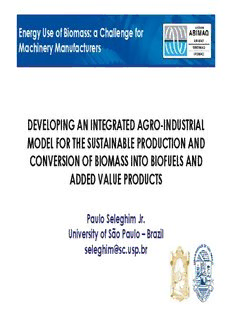
Developing an integrated agro-industrial model - Club of Bologna PDF
Preview Developing an integrated agro-industrial model - Club of Bologna
Energy Use of Biomass: a Challenge for Machinery Manufacturers DEVELOPING AN INTEGRATED AGRO-INDUSTRIAL MODEL FOR THE SUSTAINABLE PRODUCTION AND CCOONNVVEERRSSIIOONN OOFF BBIIOOMMAASSSS IINNTTOO BBIIOOFFUUEELLSS AANNDD ADDED VALUE PRODUCTS Paulo Seleghim Jr. University of São Paulo – Brazil [email protected] EEnneerrggyy uussee bbyy humankind Energy use by humankind Energy and quality of life saturation EUA Noruega HIDDHI Canadá Islândia 1,000 China target 00,,990000 0,800 Emirados Árabes 0,700 41 % increase in world India 0,600 Brasil energy consumption 0,500 China, India 0,400 Moçambique Indonesia, Brazil 0,300 0 22.50 0k0W 54.00 0kW0 76.50 0kW0 108.00 0k0W 121.50 0k0W0 pow12e0r0/0capta/year kgoe/capita/year Bioenergies will play aann iimmppoorrttaanntt rroollee iinn meeting these expectations ! But how renewable eenneerrggiieess wwiillll ddiissppllaaccee fossil energies ? MMooddeerrnn bbiiooeenneerrggiieess constitute a disruptive technology… Disruptive and incremental evolution of technology Fuel for Otto cycle engines performance 2G bioethanol energy balance ecological footprint 1G bioethanol etc. gasoline CO 2 sequestration time robustness technologies we are here energy security cost competitiveness impact on food prices worldwide applicability etc. time Fuel for Otto Cycle engines 2nd generation ethanol: promising energy vector • Produced from ligno-cellulosic fibers • Abundant feedstock (crops or wastes) •• CCaann ccooeexxiisstt wwiitthhoouutt iimmppaaccttiinngg oonn ffoooodd pprriicceess Strategic importance for Brazil – Sugarcane • Oversupply of electricity from biomass residues in SP • Need for automotive fuel (↑↑↑↑) • Sugarcane sector already mature Environmental planning Agricultural and livestock land occupation non-arable 492,6 Mha arable 354,8 Mha ppaassttuurree 117722..33 MMhhaa aavvaaiillaabbllee 110055..88 MMhhaa cultivated 76.7 Mha soya 26.6 Mha corn 14.0 Mha orange 0.9 Mha sugar cane 7.8 Mha Sugarcane sector in Brazil Characteristic numbers • Cultivated area: 7.8 Mha (0.9 % territory) • Industrial processing units: 432 plants nationwide •• SSuuggaarrccaannee pprroodduuccttiioonn:: 556622 mmiilllliioonn ttoonnss // yyeeaarr • Sugar production: 31.2 Mt/year • Ethanol production: 27 Mm3/year • Energy matrix share: 16.4% (hydroelectricity = 13%) • Electricity generation: 2.1 GW • Electricity potential: 7 GW (Itaipu = 14 GW)
Description: